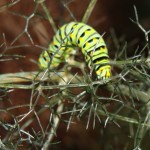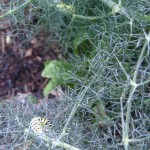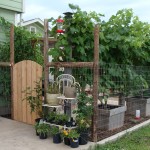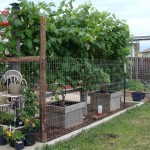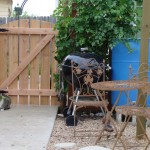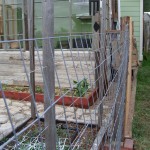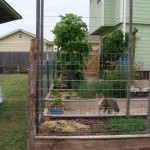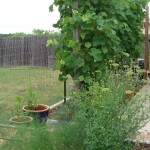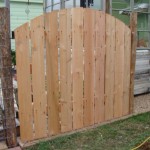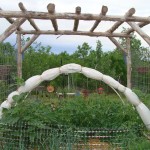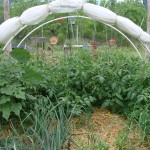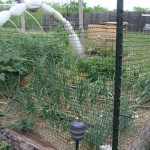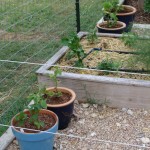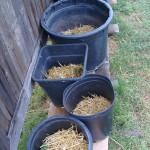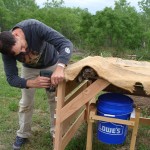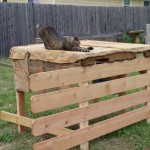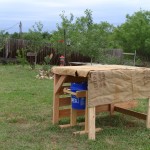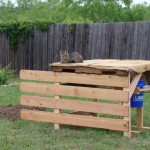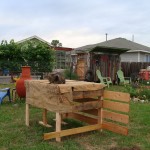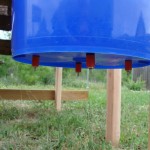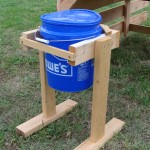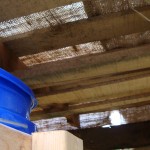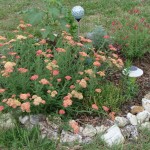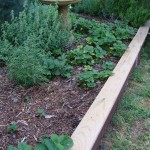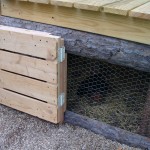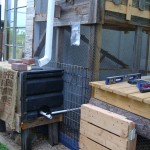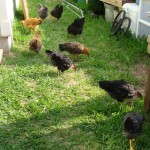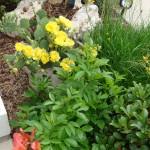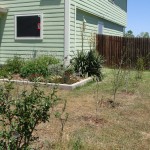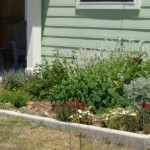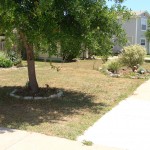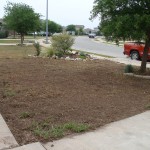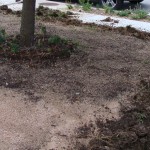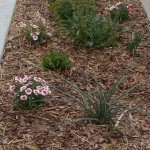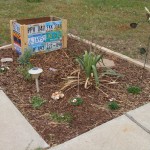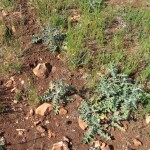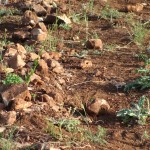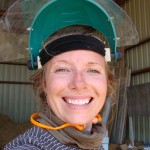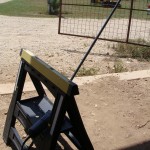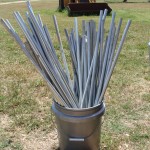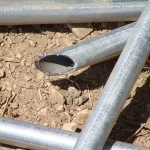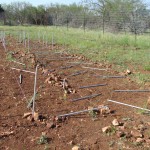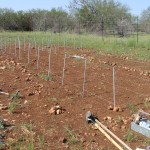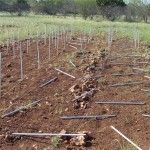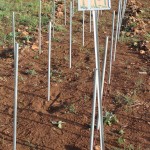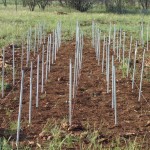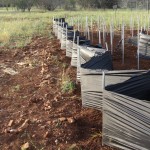Summertime Primetime
And the livin’s easy…actually far from it! Especially if you know us and our ridiculous determination.
My 35th birthday was amazing! Thank you everyone for your thoughtful wishes and splendid gifts of joy and blessings! I received a wonderful turquoise garden gnome from our great friends Will & Megan which we will add to our herb garden. Our beautiful friend Nikki gave us a great birdhouse handcrafted by her friend Harris. The birds will love it just as much as we do I’m sure! We had a marvelous evening among friends and the homemade mason jar tiki torches Davin made kept the mosquitoes away too!
I wish I could’ve posted in June but I’ve been trying to balance life and swat all the flies! We had a gathering to celebrate our spring progress at our Suburban Homestead. It’s been a very busy spring indeed! I started teaching at Green Gate Farms, New Farm Institute in June and I’m trying to transfer to Green Mountain College in Vermont in the fall. They have an innovative and empowering Master of Science Degree in Sustainable Food Systems that I would love to get! Although I have excelled during my Masters program at Texas State University I would love to have the opportunity to have a greater impact on the food movement through sustainability and Green Mountain’s program is cutting edge and in a league of its own! Plus it’s in one of the best states in America! One that we’ve even considered moving to. Plus we even have family there and throughout New England!
Davin’s added 3 fences to our backyard homestead to keep the lovely ladies(our hens) out of the beds. They have however enjoyed feasting on many heirloom tomatoes, both green and red, a number of times, thanks to Davin forgetting to check the gates before he’s let them out. He did a lot of research in the best fencing methods and went with some old school approaches. His overalls have found many uses most weekends spring and summer.
ANIMALS in General
While at Green Gate I’ve learned a little bit more about Guinea Hogs, Pigs, Chickens, Bunnies, and Goats. During Farm Camp I have had the opportunity to feed them daily, help improve some of their habitats, and ring them back into the pen. Last week the Guinea Hens and Bunnies froliced freely and I assisted in coralling them back in. The kids loved it even though it was a bit of a nuisance in the pouring rain and heat. None the less it still taught a lesson in proper livestock framework.
Yesterday a volunteer brought a baby bunny to the farm. Although he was going to feed it to the hogs, I tried to rescue it to release back in the wild. Although I did my best, little bunny didn’t make it and passed on to greener pastures this afternoon. If anything it was an experiment in the hopes that one day I’ll be more successful in rescuing such adorable creatures. I was told the success rate would be slim. I did learn what and how to feed it and the raw milk from a local farm as well as a liquid vitamin blend and water administered rather well in a dropper. It was pretty neat and cute watching it succle the food. It was about two weeks old we think. Last night we came home from the movie and it had actually jumped out of the shoe box on the counter, with a lid on, and scattered into the next room to hide under the piano. The fact that it surpassed two of our stealthiest cats won it the title of ‘Lucky’ bunny by Davin. It’s unfortunate that Lucky didn’t live another day but we learned a little bit more about raising Rabbits in the process.
CHICKEN Challenges: CROP in Trouble & Other News
We have also had to recently cull 2 of our hens at home, :(. Davin did make Chicken Noodle soup out of Elsa; one of our Golden Naked Neck Hens that had an Impacted crop for a week. After endless hours of feeding with olive oil, coconut oil, honey in probiotic yoghurt, and a little cooked egg after periods of no food because of the impacted crop (which later turned into Pendulous Crop), my husband threw in the towel; even though he wasn’t the one taking care of her the whole time! She continued to drink the probiotic and electrolyte water on her own and we noticed if we tapped the waterer with our finger it prompted her to drink fluids on her own. Staying hydrated was not an issue. She did turn a little green from the excessive amounts of olive oil we administered which could only be seen because here skin is so visible due to her breed.
We did a great deal of research individually online. I stumbled upon a very helpful website worth recommending if you have chickens; The Chicken Chick wrote a useful article; Answers from The Chicken Vet on Impacted, Sour & Pendulous Crops by Kathy Shea Mormino. Definitely worth reading and adding to your favorites. I tend to prefer finding answers in books but unfortunately my only chicken book on hand, Raising Chickens by Storey, didn’t have the answers I was searching for, even though it is a good book for a beginning chicken owner. The local bookstore I went to, Half Price Books, had one book about chickens and it was of funny looking breeds; not very useful. We are still looking for a Chicken Veterinary Book so if you have any recommendations that would be wonderful!
We also contacted several people in search of a quick and inexpensive fix even though those who raise birds for their meat or eggs in large quantities advised just to cull the hen. I was able to speak with a Veterinary Assistant on behalf of a Chicken Vet at Bastrop Veterinary Clinic who discussed other options of using antibiotics to help reduce the swelling in the crop area and that had provided success for some. Other options they suggested that I had also researched on my own was cutting the skin and removing the material myself from the crop. We heard that the surgery was risky and that we’d have to be transferred to a different doctor. We heard of a miraculous woman who has done it on her own for years using a straight edge razor blade and some craft glue (or medical grade suture glue) to stick the wound back up; from one of the Elders at Calahans. Apparently she has had reliable unended success and it works everytime. I am in search of meeting this woman and learning her trade. The other option we researched a bit was helping the bird purge the matter back through the esophagus but we also discovered that he usually resulted in fatal incidents. We did however watch a video on Youtube of a gentlemen who did this with a parrot and the video provided great detail. My husband the makeshift medic that he is, decided against both of those surgical or medical procedures because the probability of survival was so low.
By the following Monday and much nursing from myself and our blessed neighbor Amber and family; whose youngest daughter named her, Davin bid her ado. The other naked neck I had named from the start, Frankie was a tough bird and obstinate, always going her own way while free ranging, ruthless and fearless. On Sunday night she was culled because she was shaking and listless. Not sure if it was from getting injured in the coop the day before because she was startled and injured herself or from coming down with an illness in less than 24 hours. We spray the coop daily and add probiotics to their water which has proven to be very successful and highly recommended as a daily regimine by the owner of Blue Star Ranch, where we bought our organic pullets from. My husband put her out of her misery in the field using similar techniques that we learned while harvesting ducks at Munkebo Farm. He buried her in the field. All of the other birds seem to be fine and we continue to spray and administer with electrolytes and probiotics every day.
HENS in the HEAT
The heat has been a bit of a drag on our chickens but the cool clay and cement from our house allows the birds to cool down through conduction. Drinking cool water also allows the birds body to cool down too. We also have a fan located in this area and three different water sources to drink from. Vinegar has helped them continue to drink water in the heat. Our hens haven’t laid yet and we’ve never had chickens before so everything is a new experience. We haven’t had a hot summer compared to the years prior but none the less it’s warmer than they’d like for production. We’ve also read that using oats as scratch help birds eat and stay hydrated during hotter temperatures. Having birds like Naked Necks in your flock also provides more heat tolerant options. Another way to cool the birds down has been to spray them with a mist of cool water. We have the perfect mister on our hose attachment or you can purchase a misting fan. They love the breeze and the mist once they get used to it. As you may have seen in our pictures of the Hen Heat Hut for free ranging in the yard, as well as our Rainwater Chicken Waterer, we also use drip nozzles for efficiency and ease. They provide less waste and if introduced to your flock while still young(we started using them after a few months old) then they will adjust readily. We have seen them used by chicks and in large livestock establishments. We are very happy with their capabilities and the hens use them often and they work well. We additionally offer cool fruit, veges, healthy food scraps, organic whole milk and greek yogurt which the chickens enjoy. I think it helps cool them down too and they make a mess of a shower with the milk and yoghurt. Make sure your chickens have a cool habitat, fresh water, plenty of shade and safety from the sun and predators when they free range. If you need to build a Hen Heat Hut, your birds will thank you later, as well as your other pets who enjoy climbing on their new tower.
PROGRESS in the Garden
I’m happy to announce that our Eggplant, Grapes, Gold Wax Beans, Boar Heirloom Tomatoes, Marigolds, Basil, Thyme, Marjoram, Oregano, Sage, Rosemary, Lemon balm, Cilantro, Dill, Fennel, Pok Choy, Sunflowers, Quinoa, Hot Peppers, Onions, Leeks, Carrots, Romaine Lettuce, Strawberries, Chocolate Mint, Spearmint, Catmint, Catnip, Raspberries, Lavender, Chives and a large variety of other herbs, have all had a successful season. Many of them continue to bear fruit, flower, and provide sustenance and growth. We have had our most successful year since living here in the gardens. I finally feel like I’m grasping gardening a whole lot better and that everything that we’ve learned along the way has allowed us to come thus for. It’s amazingly empowering to be able to have successful gardens finally after so much effort, research and experimentation using a variety of methods. This spring I tried my hand at gardening biointensively and it has definitely shown great results especially with the size and production of many of the plants grown in small gardening spaces. Red, orange, and pink zinnias line our garden terrace. Fat sunflowers grow along side the green beans, and Morning Glory vines up along side our cucurbitaceae family bed.
Our grapes are the best, sweetest, and biggest so far and we added 2 Concord trees this spring to our wilderness. I also planted 2 Elderberry bushes and they are finally taking off. I potted 3 more blueberry bushes because my love for them is too great to quit and we tried using just peat moss this time instead since a local grower raved about the success she has seen trying just that. We added some humus, microflora and pine bark compost to the top of it too. They seem to be doing well.
We have had more rain this spring and summer than any other year that I’ve lived in Texas since 2006. I actually saw that the Barton Creek Aquifer status was no longer registering drought! We haven’t had to water much and have been very reliant on the rain. Our filtered watering system in the backyard has done wonders in maintaining the health and growth of our plants! We even planted native seed in our front yard to be more water wise. We laid down straw afterwards to help during the growing period. It continues to be a work in progress. We amended the clay soil slightly by adding 1 yard of Triple Compost and 1 yard of screened sand to the front lawn. We also used Thunder Turf, purchased from Native American Seed Company in Junction, Texas!
Our latest permaculture experiment has been gardening with straw bales. So far so good. I’ll keep you posted on that one. I planted them on the east side of the house so they get afternoon shade.
BUGS that are Back
We have been spraying every week or every other week all of the gardens with a mixture of homemade compost tea that I make in a 5 gallon bucket. We have also sprayed with sulfur to minimize the chiggers in our gardens/yard. We’ve never had a problem with them in the past but the flies, mosquitoes, and chiggers are very bad this year. We do have a great deal of beneficial insects and hummingbirds in our gardens. We don’t have any problems with birds eating our tomatoes but have heard many complaints from other gardeners that it’s a problem. We think that our permacuture set up has helped prevent this from happening. We do monitor the grapes and strawberries though because we have seen that become a problem in the past. A plastic livestock netting that you can get inexpensively at a local hardare store or garden center works fine as a covering. We have aphids on our grapes but we constantly squish them or pinch off the young growth that they’ve attached to every 2-3 days. Our Maximilian Sunflowers have been a marvelous host plant and lady bugs and other insects continue to thrive on them, reducing the destruction on other plants. Leaf hoppers are very bad this year, and we’ve had a Tomato Hornworm take out an entire bell pepper but it recovered and the hens were pleased to devour it. We continue to have many flowering herbs as hosts for the beneficial insects; herbs like basil, fennel, dill, oregano, horehound, mints, etc. have been a huge help. We leave them to flower in the gardens and they help boost pollination counts although we haven’t seen many bees this summer and more so in early spring. We have a few new citrus plants that I’ve introduced to the container garden mix but they continue to challenge me. I’m determined to get better at growing them however even though my recent research has taught me that they are more work than I initially thought. Why can’t everything grow as easy as grapes, strawberries, and raspberries do here? Just kidding. Nothing is really easy in Texas to grow, but I have figured out a lot of things that do. If you are a laid back gardener in need of good landscaping plants, stick to the natives. You won’t have to water much if at all.
RECOMMENDATIONS for your Garden
Marigolds and Basil should be replenished everywhere! I have the largest Marigold plant I’ve ever seen in my entire life simply from popping the dead heads and spreading them throughout my garden. This plant actually came from a random head I beseeded in the fall. Although I should relocate it in another area since it is taking up space and vital nutrients from our largest garden bed, I simply can’t because I want to see how big it can get! Marigolds and Basil are both essential to detering pests in your gardens. If you aren’t a large organic farmer you can surely pop the tops and spread the seed everywhere! The bugs and your gardens will love it and they both make wonderful bouquets and are great edible landscapes, especially with so many varieties! I have 15 different basil plants after ordering seeds from seedsavers. Botanical Interests has also allowed me to introduce new edible culinary varieties of Marigold to our diet.
Let the good insects live on and relocate them if you have too. Most spiders are a huge plus to your gardens. Our favorite is the “banana spider” and wolf spiders. Have you ever seen glowing eyes in the grass at night? Take out a flash light when it’s dark and shine them into the yard. The little sparkles that you see are actually from arachnids! Pretty neat or pretty scary for those who are arachnophobic. Get your hand on an insect book for bugs in your state so that you can decide on your own if they are harming or helping your garden. Every day is a new adventure in your own backyard! Especially when a bug hunt is involved! I forgot to mention that I actually saw a lightning bug a couple nights in a row while gardening by the light of the moon. That was amazing. I’ve never seen one here and something that I’m reminiscent about.
Other bugs to watch out for? Kissing bugs are very bad and we have seen them this year, they can make you very sick and leave a huge welt so be weary and squish when you can. The best organic method is your fingers, but a dilution of neem oil, citrus oil or tomato leaves, onions, garlic and hot peppers, also work wonders too! Compost tea, diluted dish soap, and milk also are other great aides. Jerry Baker has some great books out with tons of recipes for your lawn and garden. Add one to your collection. Make sure your measurements are accurate and that you aren’t spraying your plants to late or early in the day. You don’t want to burn your plants so do your research first if you haven’t tried using them before.
Praying mantis and walking sticks are great to have around, even though some have said that they can be invasive. If they eat the bad bugs they are good in my book, as long as they stay away from my precious hummingbirds! Have you ever seen a picture of a praying mantis eating a hummingbird? It’s crazy!
Toads are a good sign that your backyard oasis is in balance within the ecosystem. Make sure not to use pesticides in your lawn and garden and you can count yourself an avid organic gardener, no certification needed to grow local, fresh, inexpensive food in your own garden. Another way you can help your family flourish, by choosing to live and eat better.
Don’t forget to pick blueberries at Moorhead Blueberry Farm in Conroe, Texas! We picked 16 pounds in May with some of our Vear family members and made some new friends too! I’ve made blueberry cobbler and blueberry ice cream and have eaten plenty by the handful! I plan to can the rest. Come to the Manor Farmers Market on Wednesdays in Texas and buy one of my yummy homemade treats!
Happy Fourth of July! Thank you to everyone who has served our country in one way or another, especially the men and women in uniform. Our blessings and prayers go out to you and your families every day! We wouldn’t be here without you keeping us safe. Thank you!
Enjoy the summer trails, and for the record, Davin says I’m the scientist and he’s the engineer. What a miser.
Laughing joyfully, Kristin & Davin
